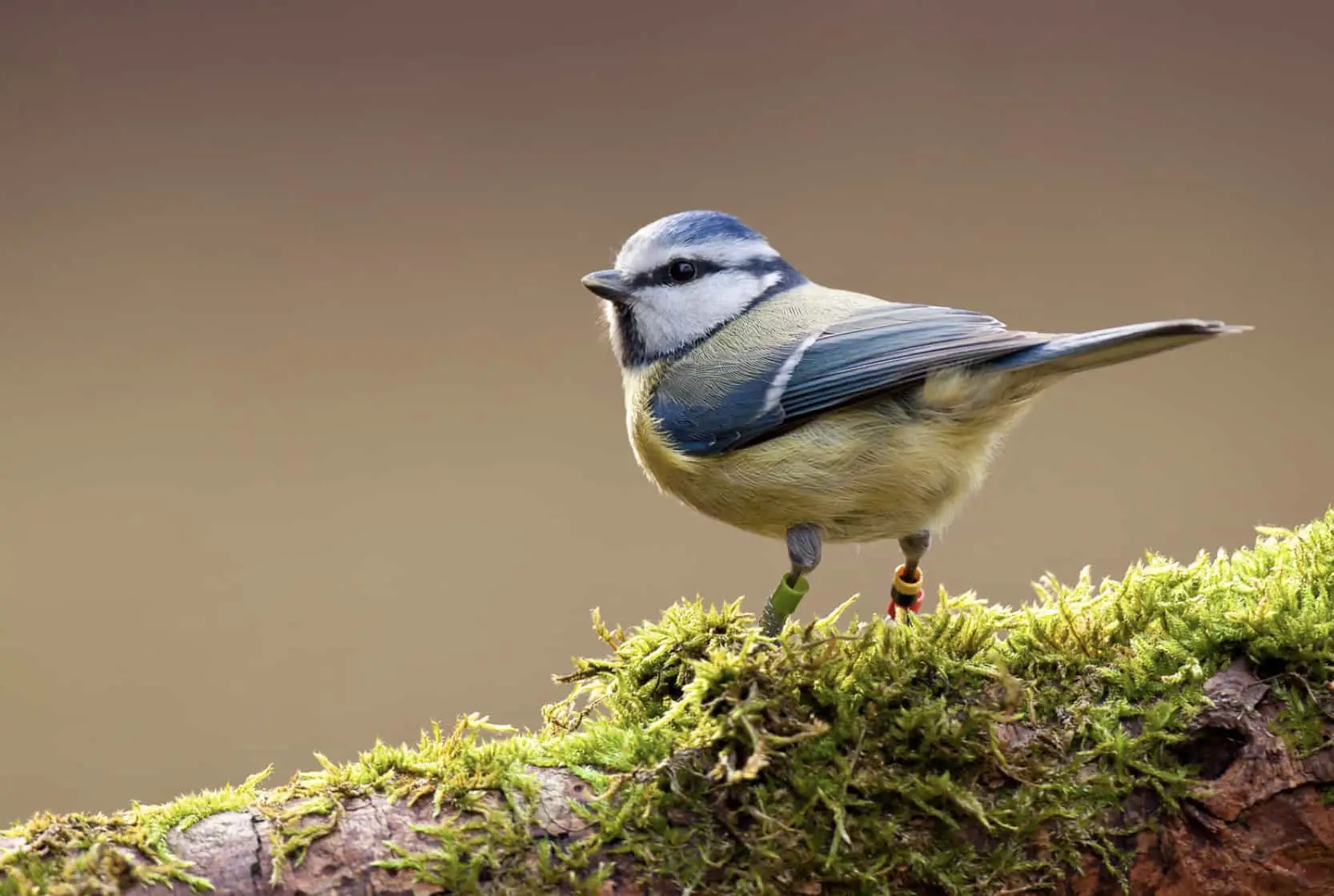Blue Tits are one of the most amusing garden birds to observe as they are very energetic and acrobatic. They hardly ever sit still while on a bird feeder and can often be seen contorting themselves to reach a specific seed. These little birds will hang, swing, and twist themselves around while eating.
Blue Tits are not particular about the type of food in a feeder, but they do favour peanuts for their fat content. In fact, Blue Tits are said to appear almost immediately upon providing peanuts in a garden. Although they love human-offered food, they are more than capable of fending for themselves.
In the wild, Blue Tits will consume a variety of small insects, spiders, caterpillars, and foraged fruits, seeds, and nuts. Caterpillars are the main diet of young Blue Tits, as they consume approximately 100 a day as hatchlings. Blue Tits that frequently visit the garden are easy to please and will consume any bird seed mixture or feed that is offered. Their favourite human-offered diet consists of mixed seed, peanuts in their shells, fat balls, and sunflower hearts.
During their breeding season, customarily in the month of March, they require a lot of fat in their diet. It is recommended to offer fat balls or suet cakes to help them keep their energy up for egg laying.
Natural Diet
Blue Tits are variety consumers, meaning they will eat almost anything they can find. In fact, scientists have discovered that Blue Tits can consume more than 400 types of food prior to their breeding season. The main staple in a Blue Tit’s diet is moth caterpillars. This type of caterpillar is especially significant during the hatchling period of their life.
A hatchling Blue Tit can consume up to 100 moth caterpillars per day. These caterpillars typically emerge in early spring, so they are thought to signal the Blue Tits’ mating season. Other prey consumed by these birds include flies, wasps, beetles, millipedes, aphids, and spiders.
Blue Tits are not particular about the type of insect they will consume, but they tend to favour species that feed on sycamore and birch buds. They will also search for fruits, nuts, and seeds that naturally grow in the region.
Human-Offered Diet
Blue Tits are easy to please and love to eat from feeders in the garden. Any type of seed mix is acceptable to them. They are fond of all season insect feast, insect and mealworm mix, mealworm feast, chopped peanuts, whole peanuts, shelled peanuts, live wax worms, and wild bird original mixes. Black sunflower seeds are a high-protein favourite too, as they appear to love pecking away the sunflower seed husk to get to the heart. These seed mixes are readily available at your local pet supply store, hardware store, or grocery store.
During the winter and breeding season, fatty foods help them to sustain their energy levels and keep warm. Fat-dense foods include fruity fat balls, peanut cakes, suet pellets, mealworm fat balls, and suet cakes – with or without insect, fruit, or seed additions. Again, these types of bird feed can be found at your local pet supply, hardware, or grocery stores. Buying online is acceptable, but it generally costs more than purchasing local, due to shipping rates.
Blue Tits are not picky eaters and will gladly consume any food that is offered in your garden. The best feeder to use for Blue Tits is a wire mesh feeder, although they will even eat off a table. The wire mesh feeder offers plenty of grip and encouragement for them to flaunt their acrobatics while feeding. These energetic birds can often be seen hanging upside down or contorting themselves on bird feeders. Be sure to regularly clean and disinfect the feeder regularly to reduce the transmission of disease. A common ailment of Blue Tits is a bacteria called Suttonella ornithocola, which can survive on feeders.
Summary
In summary, Blue Tits are omnivores that are not particular about what they consume. They will eat almost any species of small insect in the wild. Their prey includes spiders, caterpillars, flies, larvae, wasps, beetles, and more. Blue Tits are also efficient at foraging for nuts and berries. They will easily find small seeds or berries in the winter that can help to sustain their energy levels until spring, when a great supply becomes available.
In the garden, Blue Tits will eat anything that is offered and are not particular about the bird feeder used. They are very fond of sunflower hearts, peanuts, and suet. Fattier foods are of higher importance during the breeding season, typically the month of March, as the Blue Tits require a lot of energy for mating and egg laying.
The diet of hatchling Blue Tits consists mostly of moth caterpillars. A single hatchling can consume up to 100 moth caterpillars per day. A typical clutch of Blue Tits is 10 chicks, so that is 1000 caterpillars per day that the parent Blue Tits have to find.
Blue Tits are beautiful garden birds and are extremely easy to please. Leave out any type of seed mix or suet cake and they will happily visit your garden.
You may also like…
- What Do Blue Tits Eat
- Do Blue Tits Migrate: When, How & Why Blue Tits Migrate
- What Do Blue Tits Eat? The Natural & Human-Offered Diets of Blue Tits
- When Do Blue Tits Nest? Nesting Habits & Timing For The Blue Tit
- The Difference Between Male & Female Blue Tits
- Blue Tit Or Great Tit? How To Tell The Difference
- The Average Lifespan Of A Blue Tit
- When Does Blue Tit Nesting Occur
- How Many Broods Do Blue Tits Have? Everything You Need To Know About Blue Tit Eggs & Nesting
- Birds In Summer: Where Do Blue Tits Go In The Summer Months?
- How Long Do Blue Tits Live For? The Life Cycle Of A Blue Tit
- Where Do Blue Tits Go In Winter

